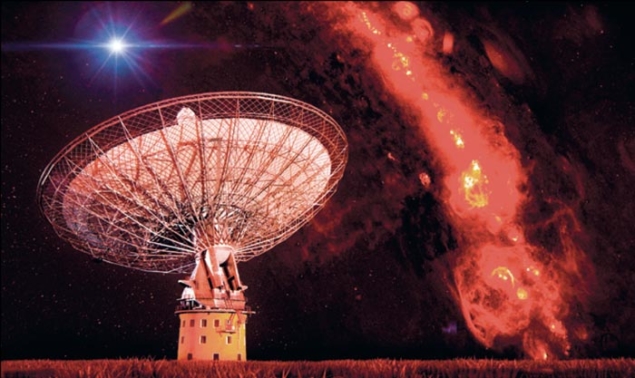
Image credit: Swinburne Astronomy Productions / http://astrometry.fas.harvard.edu/skymaps/halpha.
Astronomers using the 64-m Parkes radio telescope in Australia have detected radio transients with a duration of only 4 ms. These fast radio bursts (FRBs) are a recently discovered class of mysterious sources that are found at cosmological distances. Now, two theorists suggest that FRBs are the last signal emitted by neutron stars as they collapse to form black holes.
In 2007, Duncan Lorimer and colleagues reported finding an unexpected burst of radio emission in archival observations of the Parkes telescope (CERN Courier November 2007 p10). The distance to the burst was calculated to be far outside the Galaxy at cosmological distances and hence the inferred luminosity was huge – similar to that of a quasar. This first radio “hyperburst” is now called the Lorimer burst, or FRB 010724.
Now, an international team led by Dan Thornton of the University of Manchester and the Australia Telescope National Facility has identified four additional FRBs. All bursts are found to be at cosmological distances as inferred by their dispersion measure, which is related to the integrated density of free electrons along the line of sight to the source. The free electrons in an ionized medium scatter the radio waves and cause a time delay in the arrival of the burst that increases towards longer wavelengths. The measured delays for the four FRBs suggest a strong contribution from the intergalactic medium and that the sources are several thousand-million light-years away, corresponding to cosmological redshifts, z, of between 0.45 and 0.96. This is significantly more than for the Lorimer burst (z ∼ 0.12) and confirms the cosmological origin of these events.
The detection of these bursts at a great distance implies a strong instantaneous luminosity. However, because the FRBs last only for milliseconds, the total energy released in radio waves is relatively modest – of the order of 1031–1033 J. While this is about the energy output of the Sun in days to months, it is more than 10 orders of magnitude less than the energy released by a gamma-ray burst (GRB) or a supernova explosion (∼1044 J). With four FRBs detected in the same survey it is also possible to estimate the event rate. Thornton and colleagues find a rate of about 10,000 per day for the full sky – about one burst every 10 s. Given the number of galaxies in the probed volume, they find an event rate of one burst per thousand years per galaxy. This is about 10 times less frequent than core-collapse supernovae (CERN Courier January/February 2006 p10) but a thousand times more frequent than GRBs.
With only these characteristics and the fact that there is no known transient detected simultaneously at other wavelengths, it is challenging to speculate on the nature of the objects producing FRBs. The brevity of the emission indicates small objects, typically neutron stars. A possible candidate is a magnetar – a highly magnetized neutron star that can emit powerful gamma-ray flashes (CERN Courier June 2005 p12).
Another interesting scenario has recently been proposed by Heino Falcke and Luciano Rezzolla, affiliated to institutes in the Netherlands and Germany. They claim that there should be a population of neutron stars that are stable with respect to gravitational collapse only because they are spinning quickly. Because of magnetic breaking, their spin rate must decrease slowly during several thousands to millions of years until reaching a critical value when the star collapses into a black hole. According to the “no hair” theorem, black holes cannot keep the strong magnetic field of the neutron star. The magnetosphere would be released during the collapse and result in a radio burst. FRBs would therefore be the last “cry” of neutron stars succumbing to their own gravitational pull.





